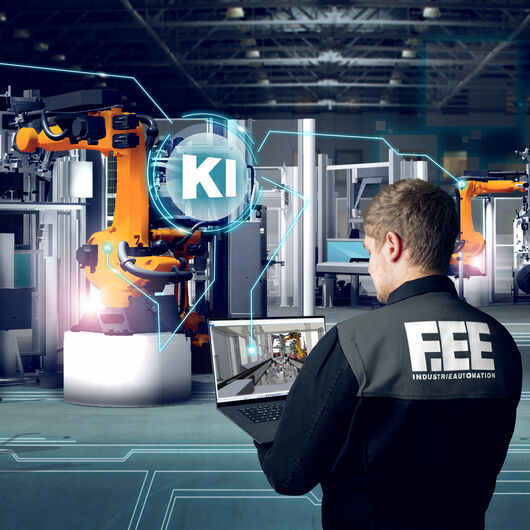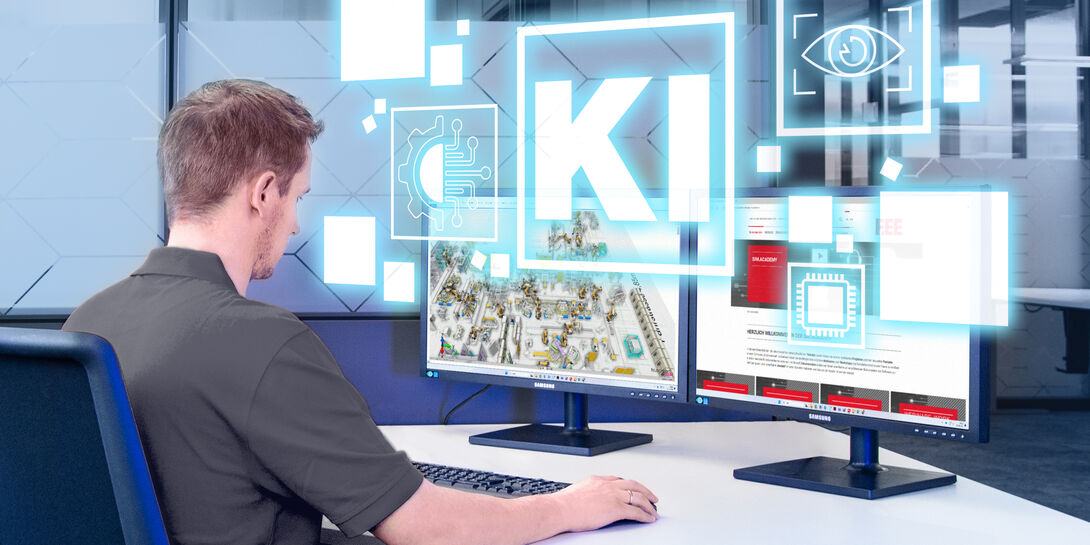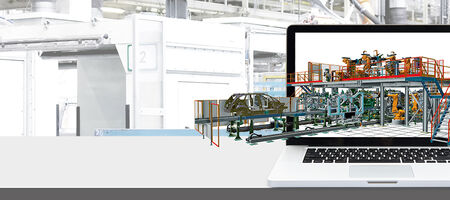Mechanical engineering of the future: How can the paradigm shift succeed?
Innovation up, costs down - AI in simulation, commissioning, operation and maintenance
He who always does what he can already do, always remains what he already is. What Henry Ford began with the consistent development of assembly line technology in automotive engineering can also be attributed in a broader sense to Richard E. Morley, the developer of the PLC. In 1969, he developed the Modicon 084, a logic system based on a semiconductor that can be seen as the original technology of today's established programmable logic controller (PLC). Today, more than 300 companies worldwide manufacture PLCs for almost all applications.
For OEMs, machine manufacturers or companies in the manufacturing and automation technology sector, such technological leaps have always been both an opportunity and a challenge: thanks to PLC integration, production plants are easier to control despite increasing technology density - fitters can intervene in a system from any location, work via remote maintenance or diagnostics and, for example, rectify faults.
One critical point remains: commissioning (IBN) and starting up production systems after a machine stop. Scenarios that often cost thousands of euros per minute and drive up the total cost of ownership.

Automation then and now
Scientists pointed out years ago that commissioning is a cost-critical process in the life cycle of production plants. The commissioning of control technology in particular is very time-consuming, which can be attributed to software errors in the system control, among other things. Even back then, the company saw opportunities to detect and eliminate errors at an early stage using hardware-in-the-loop (HiL) simulations.
The F.EE group of companies from Neunburg vorm Wald in Upper Palatinate is one of the market leaders in manufacturing and automation technology and has been involved in PLC simulation and process optimisation for around 20 years. It was therefore only logical for employees from the design, electrical and mechanical departments to focus on the critical point of commissioning. The engineers wanted to create options for safeguarding control software, test critical operating states risk-free and simulate complex processes in an early project phase. At the same time, they wanted to validate and optimise control and regulation strategies as early as the engineering phase. The result was the fe.screen-sim simulation tool, which is based on the principle of the digital twin and with which commissioning runs virtually (VIBN).
Daring virtual change: what fe.screen-sim does
fe.screen-sim creates a digital image of a system - long before it physically exists. All design, electrical and mechanical data is used. This makes it possible to check all functions and environmental parameters before the physical system is completed. As with Henry Ford, practice is what counts for F.EE: the simulation tool is currently the only multi-user-capable one and thus resolves cross-dependencies in the design process - both designers and programmers work on the model at the same time - without switching between simulation and editing mode.
This is made possible by an architecture that essentially consists of a multi-user-capable core-client application, whereby the client represents the user interface and connects to the core via the network. The calculations for the simulation model, including complex physical calculations such as those for acceleration or gravity, run in the core. The client, which also contains all standard operating elements in addition to the 3D visualisation, connects to the core. What makes F.EE different is that several clients can connect to one core. This means that several users can work on a model in parallel and can also build large projects efficiently.Cross-manufacturer compatibility with robots and PLC controllers is achieved via corresponding interfaces. If working on the screen is too two-dimensional for you, you can switch to three-dimensionality at the touch of a button using the VR module and immerse yourself in the simulation via VR goggles. As a user, you can hardly get ‘closer’ to reality and thus to component sizes or distances.
Problem solver for all players: fe.screen-sim
F.EE is also forward-thinking when it comes to data handling. The fe.screen-sim simulation software is designed for large amounts of data and guarantees the data consistency of the systems used without loss. In addition, fe.screen-sim offers an efficient utilisation of all data for model creation thanks to its range of functions and ensures consistent data preparation and structuring throughout the entire engineering process.
For machine and plant manufacturers, OEMs or industrial manufacturers, this is both a milestone and a paradigm shift: if flexibility requirements increase, fe.screen-sim - compared to other applications - ensures that production and plant parameters can be changed quickly. The validated software for PLCs, robots and other linked systems can be ‘imported’ into the plant. The rapid adjustment of parameters or the creation of situations in the virtual model is a decisive advantage compared to a pre-construction or real commissioning. Users act flexibly and therefore economically from the initial installation to the decommissioning of a system.
Global present: flexibility is key
The industry is already utilising the virtual simulation tool today and reducing costs during plant commissioning. In addition to very cost-intensive initial commissioning, geopolitical, social and economic changes are increasingly proving to be drivers for industrial manufacturers, forcing them to respond to (changing) customer requirementsfaster, more adequately and with higher quality. Another current problem is that the number of component variants is increasing, while quantities are often decreasing. In addition to greater flexibility in production, these factors also require increasing networking in order to be able to produce more efficiently, innovatively and quickly. Here too, the developers at F.EE are thinking ahead with the aim of counteracting increasingly complex value chains. The fe.screen-sim simulation tool will ensure future flexibility by integrating artificial intelligence (AI) and self-optimising systems. With fe.screen-sim, industrial manufacturers, logistics companies and large-scale plant manufacturers have a bracket that spans the entire life cycle from the planning phase of a plant to its decommissioning. This will enable demand-orientated plant operation and thus a significant influence on the total cost of ownership.

Near future: virtuality and artificial intelligence
To this day, F.EE engineers adhere to Henry Ford's credo and do more than customers expect, markets demand or trends recommend. fe.screen-sim is used for the virtual commissioning of new systems and is a valuable tool for the validation and (re)commissioning of existing systems when converting systems. Errors or deviations during virtual commissioning are recognised in good time. It is also possible to search for and find solutions or improvements with the aim of rapid physical commissioning, a fast ramp-up or smooth plant operation.
Engineers also use the simulation tool to test the feasibility of their own ideas for machine and process optimisation - functionalities that until a few years ago only existed in the imagination.
AI is now bringing even more dynamism to the industry and therefore also to virtual commissioning (VIBN): functions that are relatively easy to realise have been implemented and could be implemented in future releases. Users can utilise chatbots that intuitively provide quick and simple information - e.g. in instructions. Chatbots for voice input will follow. This harbours potential, especially when creating complex models, as manual input can be eliminated. The combination of AI and automated model creation via the API harbours great potential, especially for model generation.
The so-called ‘digital shadow’ is another promising approach: industrial manufacturers and service providers will soon be operating their digital model as a ‘digital shadow’ parallel to the physical plant. The digital model will then continuously draw data from the physical plant. Where is the probability of problems increasing? When can unplanned plant shutdowns be expected? Questions like these can be answered predictively and help to optimise processes and thus continuously improve the performance, efficiency and safety of a plant.
AI algorithms can soon be used to determine the optimum operating parameters for plants and systems and plan proactive maintenance. With its open system architecture, fe.screen-sim enables the integration of AI algorithms. With the Software Development Kit (SDK) and the Application Programming Interface (API), users have an optimal infrastructure for extracting data from the model and transferring it to the model. What's more, flexible interfaces facilitate the seamless integration of AI-supported functions into the virtual commissioning process.
Outlook and insights
The will to take fe.screen-sim to the next level is there. So are the ideas. The developers at F.EE are already thinking about the importance of AI for the simulation tool when it comes to automated generation and thus the creation of plant models.
There is also potential in the generation of test data for virtual models, which has been time-consuming to date. In the long term, the combination of AI and expertise will help to speed up this process. The idea is to use the data to simulate faulty measurements and special events in order to test and verify various plant scenarios. Another point: the optimisation of virtual plants. The fe.screen-sim of the future will make the coupling of self-optimising systems and thus the deterministic determination of the optimum position for robots in processing cells standard. Some F.EE customers are already benefiting from this today. This is made possible by AI, which will also be able to process data for MTM optimisation and determination in the future.
Another dilemma that AI could solve in the simulation tool: Checking systems after changes have been made. While these checks have been fraught with risks to date, AI systems will significantly simplify the automated verification of models by generating test scenarios (from virtual models). Keyword: increased efficiency and quality assurance: analysing signals and statuses using AI makes it possible to plan maintenance periods depending on component tolerances/product deviations. Henry Ford would have been delighted: for the developers of fe.screen-sim, these are just a few of the topics on the development roadmap.
The author Werner Pospiech is Sales Manager for industrial software (fe.screen-sim) at F.EE GmbH
Your personal contact person – for more clearness
You are a project or department manager and are faced with the question of how to set up a digital twin for your project? We would be happy to talk to you personally about your requirements, the time frame, the possible project approach and give you an initial cost estimate.


